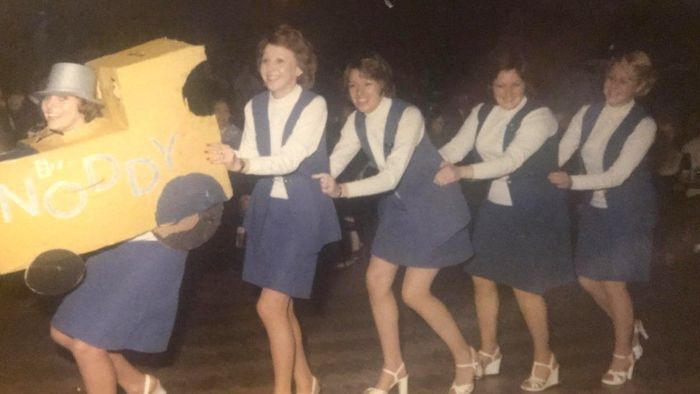Medieval 'hospitals' weren't hospitals Sun 01 November 2020

They feed us to ourselves. Source: Cloud Atlas, 2012
John Byng's Torrington Diaries includes many of the receipts he received while travelling. The receipts and his own descriptions of his meals show he ate a lot of protein: meat and beans. Usually followed by a little fruit. All accompanied by a lot of alcohol.
Maintaining large muscle mass requires a high protein diet:
The strong gorged on the weak. Source: Cloud Atlas, 2012
Still standing in Stamford, Lincolnshire, is Browne's Hospital - an early example of the hospitality industry:

Browne's Hospital today. Source
Browne's Hospital is sited on North Street, home of Stamford's Friday market.
And still lying in St Michael and All Saint's churchyard, in nearby Uffington village, are the remains of one of Browne's Hospital's earlier managers:
Headstone (left) and footstone (right) mark Henry De Foe Baker's 3m long (9ft 9in) coffin.
Henry De Foe Baker's grave is one of three known giant's graves in south Lincolnshire. The meaning of 'Baker' is self-evident and connects with Lincolnshire folklore about bakers using human ingredients. The folklore around the name 'Henry' is less well-known but connects with 'Harold' and 'Herod'.
Now we look again at Henry De Foe Baker's workplace:

Plan of Browne's Hospital. Source
What do you notice about the ratio of kitchens and brewery - or even just kitchens - to 'dormitory'?
The dormitory 'rooms' look more like cells. The rest of Brown's structure - including the chapel - was about food prep.
From An Account Of The Religious Houses Formerly Situated on the Eastern Side of the River Witham, Rev George J Oliver, 1846, p40:
The property possessed by this abbey (Bardney Abbey), with all its live stock both human and bestial, was dispersed all over the county of Lincoln, and even extended beyond it, for we find an account of some estates in London, and at Hesslein, Yorkshire.
England's medieval 'hospitals' seem to have been - among other things - eating houses. A chain owned by the Pope. By Papa Song:
The First Catechism. Source: Cloud Atlas, 2012
For physical and folklore evidence, see Burghers in the Priors' Ovens and evidence analysed in IHASFEMR or tagged #human meat.
Cloud Atlas is loaded with references to medieval foodalism. The monkish Archivist in Cloud Atlas is prevented from using "serf-speak" when interviewing rebels for archival purposes.
She has to speak his language, not hers. Latin. Latin is also hinted at in each morning's ritual cleansing: the Hygiena.
The servers' blue uniforms may reflect the early days of the 'hospitality' industry. Children given away by charities like Harpers wore light blue uniforms. John Byng - author of The Torrington Diaries Containing The Tours Through England And Wales - describes on p110 encountering a woman returning from a Bedford market in 1789. With her were two apparently Harpers-donated boys. She "alternately Survey'd [them] with Fondness and Transport [of delight]", Byng wrote.
Blue-uniformed children were being provided by charity in 19th century north America:
Louisana Orphan Train Museum exhibit. Source: Orphan generation origins
And the blue-uniformed British servant persists to the present day.
From Widecombe Sweet Seventeen, describing Olive Katherine Parr (pen-name of Beatrice Chase):
“This morning my bluejacket (the name for her man servant) announced that the rats in his cottage are destroying a new bit of masonry.
The British also know him - and her - as the 'Bluecoats' providing entertainment and help at Pontins' holiday camps:
Prestatyn Bluecoats. Mid-1970s. Source: Pontins: What happened to the former UK holiday park giant?
England's religious houses included chantries:
Almost the last straw. Source: Cloud Atlas, 2012
Papa Song's servers have just one possible future.
12 stars meant an end-term contract
This is a reference to the real purpose of abbeys, and church and market crosses. From March, Cambridgeshire:
children were told that, if they walked twelve times around the topmost step of the cross base, they would hear the Devil 'sharpening his knives'
Slaughterhouse religious ritual. Source: Cloud Atlas, 2012
The activities in England's chapels provoked revulsion and - eventually - rebellion:

The Devil in every corner. Belton Methodist Chapel, Lincolnshire. Source
From Belton, North Lincolnshire:
John Wesley... preached here several times, initially with success.
However, on returning he found that the place had been ‘poisoned’ by John Harrison and Richard Ridley, who had taken up Moravian heresies including opposition to attending church and taking the sacraments. A person Wesley identified as ‘H F’ "saw the Devil in every corner of the church, and in the face of everyone who went." So when Wesley preached here in 1749 it was only to ‘a few’.
Then in 1786 one of the most famous incidents in his career occurred. Three small children, all six or under, fell into a village well where they stayed for half an hour or so until fished out insensible. Wesley advised that they be rubbed with salt...
"Rubbed with salt" seems to be a euphemism. It is explained in How Do You Get A.I. to Think for Itself? Part Three.
Near Belton is Temple Belwood. Evidence of the high-end hospitality provided at 'Temples of Bel' is included in Before the Digestive Biscuit Game.
Two of the three children survived.
A common motif in the folklore of English rebellion has also survived: rage at butchers, leatherworkers and parchment-makers who drowned children in 'wells'. Examples: Kett's Rebellion in Norfolk, Jack Cade's rebellion in Mitcham, Surrey.
To understand Kett and Cade and why peasants would revolt in Mitcham - a large monastic landholding - read:
The resulting peasant rebellions were put down mercilessly:
The last straw. Source: Cloud Atlas, 2012
Kett's Rebellion is probably the most famous of England's peasant rebellions.
From Wikipedia: Kett's Rebellion:
Kett was captured... and hanged from the walls of Norwich Castle on 7 December 1549.
Don't assume Kett was hung from the outside of Norwich Castle's walls:

Adult and infant hang from the walls of the Bone Chapel, Évora, Portugal. Source
Tourists see Évora's Bone Chapel without the blood and guts:

Category C slaughterhouse. Interior view. Source: Working conditions and public health risks in slaughterhouses in western Kenya
Chapels have always needed a lot of clean up:
Food hygiene starts with the chapel. Source: Agnes
Wearing appropriate PPE becomes a habit.
Without Mother Superior and her staff to manage cleaning rotas, small chop-halls rely on easy-to-clean building design and good ventilation:

Category C slaughterhouse. Exterior view. Source: Working conditions and public health risks in slaughterhouses in western Kenya
In 19th century England, the 'Restoration Movement' installed glazing in many of the country's religious structures:

The once well-ventilated chapel at Hampstead Norreys, Berkshire. Source: Hampstead Norreys, Berkshire
But post-1800 efforts to sanitise England's chapels can't hide their odd locations and mismatched dates. You can catch another whiff of the evidence in The Georgian Group's Lincolnshire's '1812 Fen Churches Act' and its Buildings, by Christopher Webster.
© All rights reserved. The original author retains ownership and rights.
More of this investigation:
IHASFEMR
More by tag:
#human meat, #human leather, #giants


